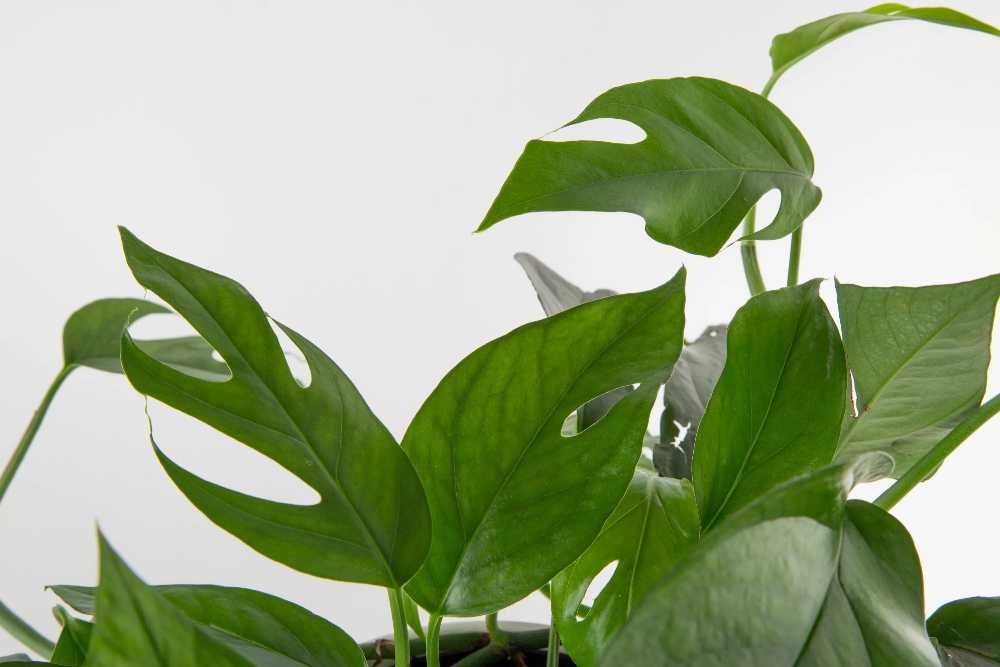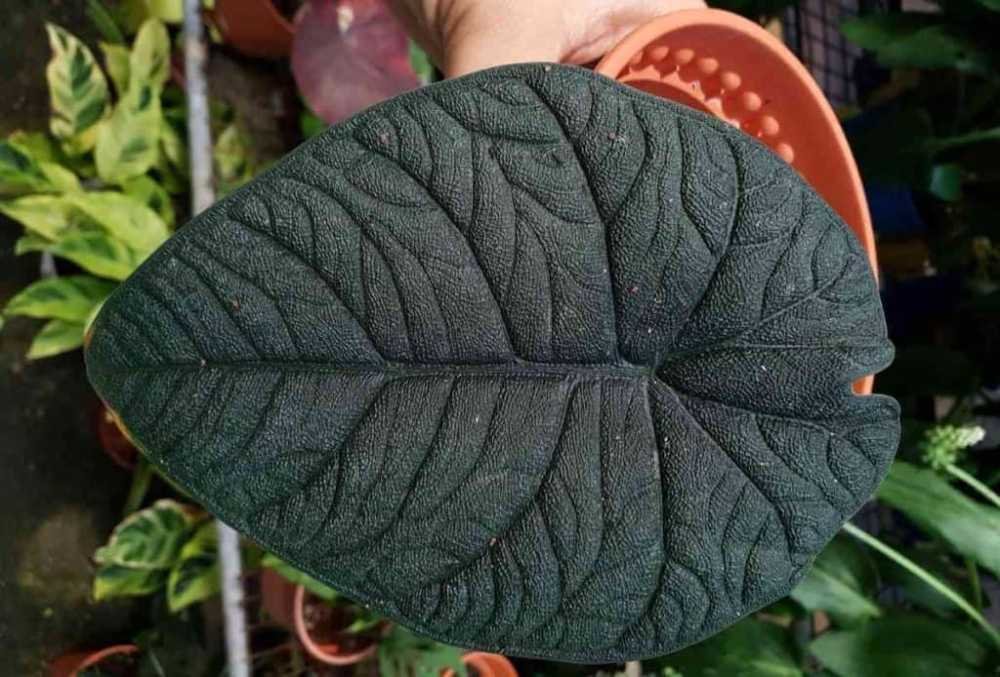Baltic Blue Pothos has grown in popularity among indoor gardeners due to its unique appearance and rarity. The plant’s foliage has blue hues, making it an eye-catchy addition to any space. It is also highly versatile, adaptable, and low-maintenance. Read on for more information about the Baltic Blue Pothos and how to grow and care for it!
What is Baltic Blue Pothos?
Baltic Blue Pothos is a cultivar of the Pothos plant (Devil’s Ivy). It is scientifically known as Epiprenum pinnatum”Baltic Blue” and was designed by Costa Farms and released in 2022. Pothos plants, from which the Baltic Blue Pothos is derived, are native to Southeast Asia, including Malaysia, Indonesia, and the Philippines. It is also native to Australia.
Baltic Blue Pothos is a tropical climbing plant whose adaptability allows it to flourish in diverse environments. Besides being a perennial vine, it is a heart-shaped leaf plant with fenestrated leaves. The leaves boast of dark green color, which develops a blue tint as the plant matures. They also have a waxy and glossy appearance.
Like its parent plant, Baltic Blue Pothos is toxic when consumed by animals and humans. Therefore, keep it out of reach of pets and children. While the Baltic Blue Pothos is a rarer find than other cultivars, it is beginner friendly and doesn’t require much effort. It also develops fenestrations earlier than other cultivars.
For indoor gardeners who love fast-growing plants, this one is for you. It is also easy to care for and can grow as big as 12 ft upon maturity. You can expect your plant to bloom during spring and summer.
How to Care for Baltic Blue Pothos
To grow the perfect Baltic Blue Pothos indoors, you only have to provide warm temperatures, water regularly, and plenty of light. However, it is a hardy plant that can do with a few missed watering sessions. Below are tips on how to care for Baltic Blue Pothos for the best results.
Light
Baltic Blue Pothos requires moderate to bright indoor light, although it can survive low-light conditions. However, growing it in low light means the leaves will remain small and may not fenestrate. Your plant will also be leggy due to inadequate light.
Similarly, too much light is harmful to Baltic Blue Pothos. Exposing it to direct sunlight will cause it to suffer leaf burns.
Temperature
Keep your Baltic Blue Pothos in a room with temperatures between 650F and 850F. This means normal indoor temperatures are okay. Since it is a tropical plant with no frosty-hardiness, ensure the temperatures do not drop below 550F.
Do not subject the plant to abrupt temperature changes, as it will shock it and cause the leaves to droop and even fall off. As such, place it away from drafts, air conditioning, heating vents, and radiators.
Humidity
A high humidity level of 50%-60% encourages faster growth and big leaves. Moist air also discourages pests. Since Baltic Blue Pothos does well in high humidity, keep it next to other high-humidity plants to boost humidity levels.
You can also use a humidifier, a pebble tray with water, or mist it once a week when the air gets dry. Fortunately, Baltic Blue Pothos can also tolerate moderate indoor humidity levels.
Soil Type
Well-draining, acidic soil is ideal for growing Baltic Blue Pothos. Get a potting mix with a pH of 4-5, good drainage, and moisture retention. A good choice is combining regular potting mix with perlite or orchid bark. The orchid bark will contribute to better aeration and prevent the soil from compacting.
Watering
Water your Baltic Blue Pothos regularly, but allow the top two inches of the soil to dry between sessions. When watering, soak the plant until water comes out of the drainage holes to make the soil evenly moist. Doing so also eliminates air pockets in the soil.
Note that the plant is sensitive to overwatering. Letting it sit in waterlogged soils puts it t risk of root rot, which is why you must control your watering frequency.
Fertilizer
Baltic Blue Pothos greatly appreciates fertilizer during its growing season. Dilute balanced fertilizer for foliage plants to half its concentration and apply it monthly during spring and summer.
The plant goes dormant in winter, so you don’t need to fertilize it. However, you can continue applying fertilizer if you use grow lights, as the plant will still be developing new growth.
Pruning
The only time you might have to prune your Baltic Blue Pothos is when you want it to grow in a specific way. You can also prune it to remove old yellow leaves and give the plant a cleaner appearance. If your plant has leggy stems, pruning it will stimulate new growth. Always use a sharp knife when pruning, and also wear gloves as the plant is poisonous.
Repotting
Since the Baltic Blue Pothos is a fast grower, you should expect to repot it every one or two years. You will know it is time to repot when you notice roots growing out of the drainage holes or bulging on the top of the pot.
When repotting, always choose a pot one or two inches bigger, and use fresh soil. It is advisable to repot during spring or summer when the plant is in its growing season.
Propagation
You can propagate Baltic Blue Pothos any time you want using stem cuttings. However, the best time to do this is during spring and summer. Using a sharp knife, or scissors, obtain stem cuttings with at least 2-3 nodes from a mature and healthy plant. Remove the bottom leaves to show the nodes before dipping the stem cuttings in water.
Make sure that the nodes are submerged while the leaves are not. Also, change the water to prevent bacteria growth. Once the roots develop, you can transfer them to well-draining soils. Keep the soil moist during the first week for the roots to acclimate before letting it dry out between watering sessions.
Benefits of Baltic Blue Pothos
Having Baltic Blue Pothos in your home or office beautifies your space and impacts your physical and mental well-being. Below are the benefits you enjoy when you keep Baltic Blue Pothos as a houseplant.
1. Visual Appeal
There is no doubt that Baltic Blue Pothos is a beautiful houseplant. With the unique, blue-tinted leaves and trailing vines, it can add charm to any space you put it. Whether you place it in your living room or office, Baltic Blue Pothos is sure to enhance the visual appeal of your space with its unique foliage.
2. Air Purification
One of the most effective air-purifying plants is the Baltic Blue Pothos. It can absorb toxins and pollutants through its leaves and roots, leaving you with fresher and cleaner air. Common toxins include benzene, formaldehyde, and carbon monoxide, which can cause headaches and dry eyes.
By absorbing pollutants and releasing oxygen, you can enjoy better air quality and protect yourself from irritation and respiratory illnesses.
3. Stress Reduction
Interacting with houseplants can significantly reduce stress levels and contribute to better mental health, according to the PubMed. What’s more, even the potting mix harbors microbes that act as natural antidepressants, helping you keep anxiety away.
By keeping this indoor plant, you create a healing environment that will boost your mood and contribute to your psychological well-being.
Creative Ways to Style and Display Your Baltic Blue Pothos
Given its versatility, you can play around with styling and display ideas to give your room the perfect aesthetics. Just because it is a trailing plant doesn’t mean your options end at providing a support structure for it to climb. Here are a few creative ways to style and display your Baltic Blue Pothos for maximum ornamental effect.
Hanging Baskets: One of the easiest ways to display Baltic Blue Pothos is by placing it in hanging baskets. The vines will create a cascading effect as they grow downwards while preserving your floor space. Hang it from the wall or ceiling and use macramé hangers or decorative baskets for the best results.
Trellis: Tap into the nature of Baltic Blue Pothos by installing a trellis or moss pole in your living space. You can train the plant to wrap around the pole as it grows by guiding the vines around it. The result is a vertical display of your unique plant that adds a touch of elegance to your room.
Terrariums: Use an enclosed glass terrarium to create an indoor garden with your Baltic Blue Pothos. You can place other humidity-loving plants like ferns in the terrarium and add moss and decorative pebbles to complete the garden landscape. Your terrarium can sit on a table, shelf, or by the window.
Live Wall Art: If you love art, you can mount a sizeable frame on the wall and use it to create a live wall hanging. Attach a wire grid behind the frame and train your plant to weave through it. The Baltic Blue Pothos will act as your live wall hanging, complete with the frame.
Common Problems with Baltic Blue Pothos
Although Baltic Blue Pothos is a hardy plant, it is not completely immune to problems. Below are common issues you may experience when growing the Baltic Blue Pothos.
1. Leaves Fail to Fenestrate
Failure of the Baltic Blue Pothos to fenestrate means it is getting insufficient light. In such cases, the plant keeps its leaves small to conserve energy.
To remedy the situation, relocate the plant to a place with brighter, indirect light and wait a few months. Sometimes, the plant may just be too young to fenestrate, and you can only wait.
2. Yellow Leaves
Yellow leaves are a sign of poor growing conditions. The culprit could be low light, overwatering, and sometimes a pest infestation. It may also be old leaves dying off.
If you notice even younger leaves yellowing, assess the plants growing conditions and make the necessary adjustments. This can be switching light conditions and changing your watering frequency.
3. Brown Spots on Leaves
The most common cause of brown leaf spots in Baltic Blue Pothos is under watering or low humidity levels. Increase your watering frequency and boost humidity levels by misting or humidifier to help the plant recover. Also, keep the plant away from drafts.
4. Pests
Common houseplant pests like mealy bugs, aphids, and spider mites can attack your Baltic Blue Pothos. Check the leaves for sticky residue, webbing, and cotton-like puffs. In case of pests, use insecticidal soap to eliminate them, and alternate it with neem oil for prevention purposes.
5. Diseases
Baltic Blue Pothos can suffer root rot caused by overwatering. Signs to look out for include limp/yellow stems and leaves, dark mushy roots, and heavy/soggy soil.
If you suspect root rot, leave the soil to dry out before uprooting the plant to check the roots. Remove the affected ones and repot the remaining plant in a disinfected pot and fresh soil.
Baltic Blue Pothos: Conclusion
Baltic Blue Pothos is a unique and interesting plant that can transform any space with its blue-tinted and fenestrated leaves. Besides being aesthetically pleasing, it is great for cleaning your indoor air and keeping your mental health in check.
Since it is a resilient and low-maintenance houseplant, anyone can get it, regardless of gardening experience. Consider adding the Baltic Blue Pothos to your plant collection to elevate your indoor space and reap all its benefits.



